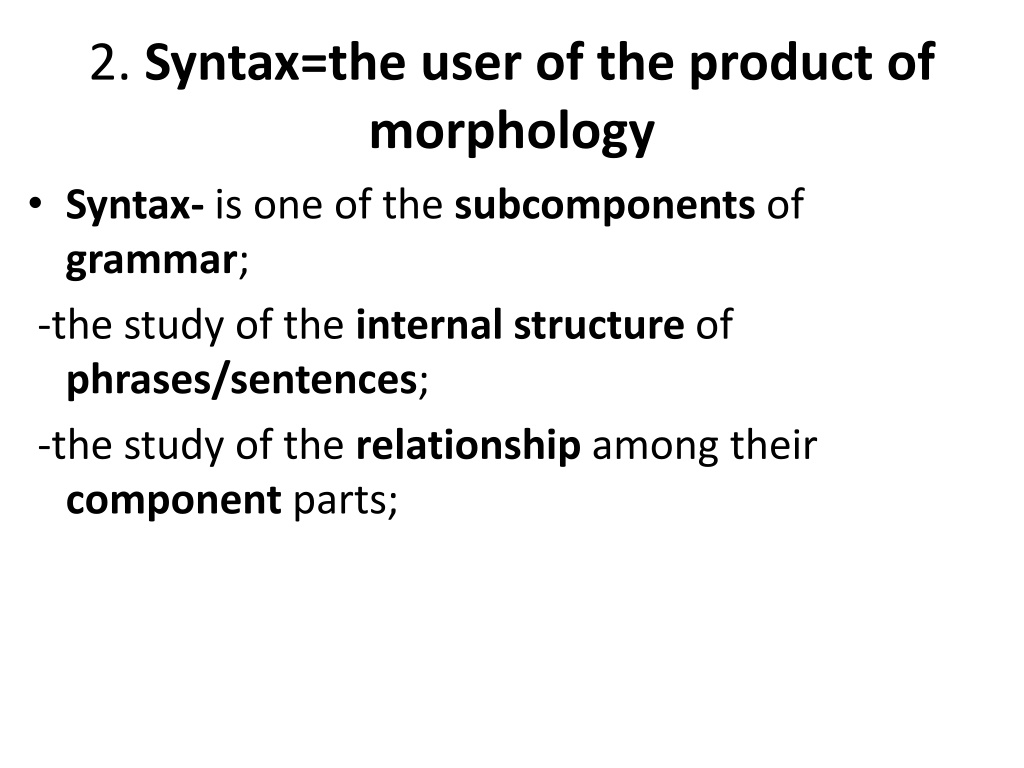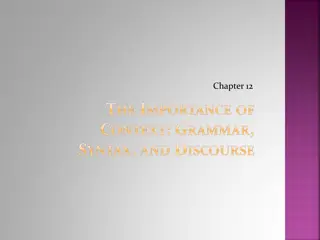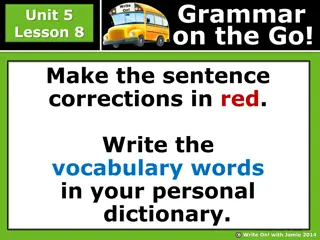Understanding Syntax and Grammar Components
Syntax is a vital subcomponent of grammar that involves studying the internal structure and relationship of phrases and sentences. Grammar components include Lexicon/Vocabulary, Phonological Form, Syntactic component/Grammar, and Logical Form. Constituents are parts that combine to form a whole structure, determined by movement criteria. By understanding constituents through movement tests, the structure of sentences can be analyzed effectively.
Download Presentation

Please find below an Image/Link to download the presentation.
The content on the website is provided AS IS for your information and personal use only. It may not be sold, licensed, or shared on other websites without obtaining consent from the author. Download presentation by click this link. If you encounter any issues during the download, it is possible that the publisher has removed the file from their server.
E N D
Presentation Transcript
2. Syntax=the user of the product of morphology Syntax- is one of the subcomponents of grammar; -the study of the internal structure of phrases/sentences; -the study of the relationship among their component parts;
2.1 Components of grammar=Language system I. Lexicon/Vocabulary/dictionary--provides lexical items II. PF component/sound--Phonological Form III. Syntactic component/Grammar-- a. PSR-Phrase Structure Rule b. TR-Transformational Rule IV. LF component/meaning--Logical Form =Any form of language contains words (Lexicon); -words are made up of sounds (PF) -words are arranged in some way to make structure (PSR/TR) -words are arranged meaningfully (LF).
Eg. [man, ball, hit, the] -The lexicon provides the lexical items with the category (man N, ball N, hit V, the Det) and the PF determines the sound/pronunciation of words; the phrase structure rule provides the structure/skeleton with the word categories. -The LF governs the acceptability of the arrangement of items and -TR- is applied for further structures (questions, and others)
PSR= provides the structure/skeleton S NP VP Det NP N V Det N 4
2.2 Constituents= Constituent: one of the parts of something that combine to form the whole. -It is a unit or part of a given larger structure. Eg. John slept. John left home. The boy left home. Colorless green ideas sleep furiously.
Criteria for determining constituents -some words are grouped together to form a unit to the exclusion of other words within the sentence. 1. Movement=within a sentence some group of words may move around together as a unit and others cannot. -the fact that a given sub-string of words can move is evidenced that it is a constituent. Eg. Change the following sentence in to passive and question. =I have seen those 3 pictures of Mary. Passive= Wh-Question (which)=
On the other hand, 3 pictures of cannot be moved as a unit, and it tells us that it is not a constituent. Example: a. *3 pictures of have been seen those Mary by me. b. *Which 3 pictures of have you seen those Mary? -Therefore, one way to ascertain the constituency is to find out whether the given string can move around in the given sentence.
2. Coordination=if a given sub string of words can be shown to be joined with another, then both sub-strings are constituents. -only constituents (of same type) can be conjoined. Example: a. I met your mother and father. b. Is she in the kitchen or in the bathroom? c. He has a cat and a dog. d. He speaks very slowly but very articulately.
The difference between movement and coordination In movement, the larger/whole part of the structure is moved, but in coordination, part of the larger structure can be coordinated with another similar structure, Example: John bought the large cup. a. The large cup was bought by John. b. *Large cup wasbought the by John. c. John bought the large cup and the small picture. d. John bought the large cup and small picture. -This shows that, coordination is a sufficient condition for a constituent, movement requires further conditions to be satisfied. -whereas all constituents can be coordinated, only constituents that are maximal in size can be moved.
c. Pronominalization or substitution -Certain substrings of words in a sentence behave as a constituent in the that they may be substituted by a single word---a pronoun or other pro-forms. Example: 1. Substitute the underlined structure with a single word. a. The book on the table is on sale. b. The man who came yesterday is my brother. c. I ran up the hill. 2. How many constituents does the underlined structure have in each of the following sentences? a. I put the book on the table. b. I gave a book to the man.
d. Ellipsis or omission -Given an appropriate context, a constituent may be omitted in whole at the same time, but a non constituent cannot be omitted. Eg. a. John loves his mother, and Bill loves his mother. - John loves his mother, and Bill does ___ too. b. John could talk to Bill yesterday, but I could not talk to Bill yesterday. - John could talk to Bill yesterday, but I could not__________. c. John left for the trip yesterday, and Mary left for the trip yesterday. -John left for the trip yesterday, and Mary did ____too. =This concept is applicable in teaching eco-construction
2.3 Phrase Structure (Phrasal Category) Word category=Phrasal category (N=NP, V=VP, AJ=AJP, AV=AVP, P=PP) Components of Phrase structure =Specifier-Head-Complement (SHC) a. Head the obligatory element of a phrase (N/V/A/P) b. Specifier -semantically, makes the meaning of the head more precise; -syntactically, it is attached at the top level of the structure, to the left of the head.(det for N/Qual for V and Deg for A/P) c. Complements -to complete the meaning of the head; it is attached the right of the head.
PossibleOrganizationsof phrase structures a. Only head phrase Example: NP He likes books. VP -All animals eat. AP She is certain. PP He went in. b. Specifier and head phrase Example: NP The man is tall. VP Non living things never die. AP The boy is very tall. PP He was almost in.
c. Head and complement phrase Example: NP -King of the country declared war. VP The man killed the lion. AP He is certain about the incident. PP I am in a class. d. specifier-head-complement phrase Example: NP The king of the country declared war. VP He never eat a hamburger. AP I was quite certain about Mary. PP He was almost in the house.
Phrase Structure Rule (PSR) for the different types of phrases 1. PSR of Noun Phrase (NP) a. Boys like basketball games. b. The Boys like basketball games. c. Tall Boys like basketball games. d. The tall bays like basketball games. NP-----(Det) (AP) N
PSR of Noun Phrase (NP) a. Boys from this school like basketball games. b. Boys who are tall tend to like basketball games. c. Boys from this school who are tall tend to like basketball games. NP-----N (PP) (S)
a. The king of England had unhappy life. b. The young king of England had unhappy life. c. The young king who gave up his throne had unhappy life. d. The king of England who gave up his throne had unhappy life. NP----- (Det) (AP) N (PP) (S) =This rule tells us the possible order and elements of a noun phrase. Exercise: rewrite all the possible PSRs of NP.
1. Verb Phrase (VP) a. John died. ( VP---V) b. John saw Bill. (VP---V NP) c. John lived in USA. (VP---V PP) d. John thought Bill kicked the bucket. (VP---V S) e. John gave the boy a nice gift. (VP---V NP NP) f. John put the book on the table. (VP---V NP PP) g. John told the little boy he won a prize. (VP---V NP S) NP =VP V (NP) PP S
3. Prepositional Phrases (PP) a. The train pulled in. (PP---P) b. John lived in the garage. (PP---P NP) =PP --------P (NP) 4. Adjective Phrase Eg. Good, very good, extremely young, quite certain about; =AP --------(deg) A (PP)
Phrase Structure Rules NP------(spec) N (comp) VP------(spec) V (comp) PP------(spec) P (comp) AP------(spec) A (comp) AdvP------(spec) Adv (comp) The XP Rule XP------ (spec) X(comp)
5. Sentence a. Traditional view of sentences =S -------- NP VP E.G. A scientist discovered the answer. b. Contemporary view of sentences =S =IP-------- NP Aux VP =Aux--------Tense (Modal) (Perf) (Prog) E.G. A scientist discovered the answer.
6. Coordinate Structure Properties of coordinate structure 1. There is nolimit on the number of coordinated categories that can appear prior to the conjunction. Eg. I bought a book, a pencil, an eraser and a pen. 2. A category at any level (a head or an entire phrase) can be coordinated. Eg. Book and magazine/ up and down (head)
3. Coordinated categories must be of the sametype. -NP and NP/VP and VP--- 4. The category type of the coordinate phrase is identical to the category type of the elements being conjoined. =VP-----VP and VP =NP-----NP and NP =PP-----PP and PP Eg. John ran up the mountain and down the river. PP-----PP conj PP X------X ((Conj) )Conj X (X can be word level or phrasal level)
Structural Ambiguity A word may have more than one meaning, so that such a word is ambiguous. Eg. I got a mouse (ambiguous) today. The different meanings of an ambiguous word can be determine in context of use. A structure may also have more than one meaning, so that such a structure is ambiguous structure. The different meanings of ambiguous structures can be determined by using different structures in a tree diagram.
Example of structural ambiguity 1. The old man and woman 2. The mother of the boy and the girl will arrive. (use verb to be and tag question to see the two meanings) a. The mother of the boy and the girl is arriving. b. The mother of the boy and the girl are arriving. c. The mother of the boy and the girl will arrive, wont she? d. The mother of the boy and the girl will arrive, wont they?
The boy saw the man with the telescope S NP VP Det N V NP PP Det N P NP Det N The boy saw the man with the telescope Write the Meaning of this structure. 26
The boy saw the man with the telescope S NP VP Det NP N V Det N PP P NP Det N The boy saw the man with the telescope Write the Meaning of this structure. 27
7. Embedded Structures -we discussed simple sentences, conjoined sentences and embedded clauses/sentences. Eg. a) John told the little boy he won a prize. b) The man who was mixing it fell into the cement. -However, there are other embedded structures that our PSR cannot generate. -We find embedded clauses preceded by elements like, that, if, whether, for a. I know that she won the grand prize. b. I wonder if she won the grand prize. c. John and Bill asked whether we would meet them. d. I prefer for you to tell me the truth. that, if, whether and for function to introduce sentential complement. Thus, these elements are complmentizers.
The use of complmentizer is also seen with a clause embedded within NP. EG. a. We believe the claim that the chicken existed before the egg. b. I like the book which she bought at the newsstand. How can we amend the PSR to accommodate sentential complements? Look at the relationships of a complmentizer with the rest of the sentence. There is evidence that the complmentizer forms a constituent with the embedded S in each case, since the string Complmentizer+S passes at least one test of constituency:
Eg. a. That she won the grand prize, I know. (movement) b. The theory that you developed and that your friends believe won t hold much water. (coordination) c. The theory you developed won t hold much water. (embedded clause without complmentizer) -complmentizers are optionals. S -----(Comp) S Comp-----that, whether, if, for, which, why,
Revise the PSRs of NP, VP and S; PSR of NP and VP: NP------ a. pronoun b. (Det) (AP) N (PP) (S ) NP VP-------V (NP) PP S
Revised rule for S=IP EG. a. That he won the grand prize surprises me. b. Why he left puzzles me. NP S-------- S (AUX) VP AUX----- Inf Modal (Perf) (Prog) Comp----C S =CP-----(C) S
Deep Structure vs. Surface Structure Deep Structure = PSR + Lexicon Surface Structure =TR TR=Affix Hopping/Subject Auxiliary Inversion/Do-support/Wh-movement
1. Affix Hopping=for Declarative sentences Affix hopping-the process of attaching an affix to a verbal element. -when you have an affix in the P-marker immediately followed by auxiliary or verbal element, attach the affix to the immediately following element as a suffix. AUX---Tns (Modal) (Perf) (Prog) Modal---will/may/can Perf------have/has Prog----be/-ing Eg. John would be singing. (How is it derived?) Lexicon+PSR =John ed will be ing sing=DS TR/Affix Hopping =John will+ed be sing+ing = =John would be singing=SS
2. Subject Auxiliary Inversion=for Yes/No Questions -Invert the subject and the auxiliary position; -Bring the auxiliary before the subject; Eg. John will see Bill tomorrow. What will be the Yes/No question?
3. Do-Support=for Yes/No question -The rule says, insert verb to do immediately after the tense affix to support that affix; -insertion of verb to do in order to support the process of Yes/No question formation when there is no auxiliary element in the declarative sentence. Eg. Mary loves John. Lexicon+PSR=Mary es love John.=DS SAI=es Mary love John.= Intermediate structure Do-Support=es do Mary love John. =Inter. structure Affix Hopping=do+es Mary love John. Does Mary love John?=SS -The order of transformational rules= SAI Do-Support Affix Hopping
Rule of Passive formation Eg. John cheated Bill=Bill was cheated (by John) Rules/Operations a. Remove the subject of the active sentence from the subjectposition and make it an optional PP at the end of the sentence; b. Move the object to the vacatedsubjectposition; c. Insert the passive-morpheme that consists of the sequence be-en (verb to be and past participle), as the rightmost element of auxiliary before VP;
Eg. =DS of the active=John ed cheat Bill. =Remove the subject=ed cheat Bill (by John) = Move the object=Bill ed cheat (by John) =Insert passive morpheme=Bill ed be-en cheat (by John) = Affix Hopping=Bill be+ed cheat+en (by John) = SS of passive=Bill was cheated (by John) =The meaning of the active and passive are the same because both are derived from the same DS. =Active and passive are synonyms/paraphrases =phoneme/allophones, morpheme/allomorphs, D-S/SSs
4. Wh-question/information/content question -Move a wh-word to the beginning of the sentence; Eg. John bought a book.=What did john buy? -John ed buy a book=DS -John ed buy what=information missing -What John ed buy---- wh-movement triggered by Q morpheme -What ed John buy SAI -What ed do John buy---Do-Support -What do+ed John buy Affix Hopping -What did John buy?=SS
5. Negativeformation= place the negative element (not) after auxiliary; Eg. John did not come yesterday. -John ed come yesterday= DS -John ed not come yesterday= placement of Negative -John ed do not come yesterday= Do-Support -John do+ed not come yesterday= Affix Hopping -John did not come yesterday= SS























